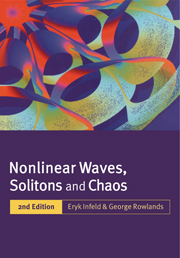Book contents
- Frontmatter
- Contents
- Foreword to the first edition
- Foreword to the second edition
- 1 Introduction
- 2 Linear waves and instabilities in infinite media
- 3 Convective and non-convective instabilities; group velocity in unstable media
- 4 A first look at surface waves and instabilities
- 5 Model equations for small amplitude waves and solitons; weakly nonlinear theory
- 6 Exact methods for fully nonlinear waves and solitons
- 7 Cartesian solitons in one and two space dimensions
- 8 Evolution and stability of initially one-dimensional waves and solitons
- 9 Cylindrical and spherical solitons in plasmas and other media
- 10 Soliton metamorphosis
- 11 Non-coherent phenomena
- Appendices
- References
- Author index
- Subject index
- Plate section
8 - Evolution and stability of initially one-dimensional waves and solitons
Published online by Cambridge University Press: 05 June 2012
- Frontmatter
- Contents
- Foreword to the first edition
- Foreword to the second edition
- 1 Introduction
- 2 Linear waves and instabilities in infinite media
- 3 Convective and non-convective instabilities; group velocity in unstable media
- 4 A first look at surface waves and instabilities
- 5 Model equations for small amplitude waves and solitons; weakly nonlinear theory
- 6 Exact methods for fully nonlinear waves and solitons
- 7 Cartesian solitons in one and two space dimensions
- 8 Evolution and stability of initially one-dimensional waves and solitons
- 9 Cylindrical and spherical solitons in plasmas and other media
- 10 Soliton metamorphosis
- 11 Non-coherent phenomena
- Appendices
- References
- Author index
- Subject index
- Plate section
Summary
A brief historical survey of large amplitude nonlinear wave studies
This chapter singles out some nonlinear wave phenomena for detailed treatment. Although we believe these phenomena to be important, we also feel we owe the reader a broader view of various research areas that have developed over the years. Of course, the survey of this section is still somewhat selective, but it does offer the opportunity of reaching much of the generic work on the subject.
During the 1960s the limitations of treating nonlinear waves by expanding in powers of their amplitude A became embarrassingly evident. Fluid dynamists were the first to realize the need for new methods, and they were closely followed by those working in plasma and condensed matter physics. Although, as we saw in Chapter 5, quite a lot of physics can be introduced through the back door of A2 theory, some large amplitude effects cannot. A few examples, some of which have been known to navigators and fluid dynamists for quite a long time as observed phenomena, are:
The formation of sharp crests on steady profile waves.
The formation of ordinary (single hump) and envelope solitons on the water surface and their dynamics.
Wave breaking. (One way this can happen is when a large amplitude wave propagates into a region of shallow water. This is familiar from summer holidays on the beach.)
Nonlinear waves evolving into soliton trains.
- Type
- Chapter
- Information
- Nonlinear Waves, Solitons and Chaos , pp. 202 - 267Publisher: Cambridge University PressPrint publication year: 2000



